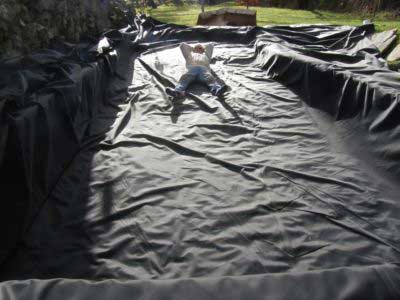Choosing a pond liner can be a challenge if you don’t know what to look out for. Pond liners come in different types, materials and thicknesses all designed with one primary purpose and that is to hold water. There are many liner materials on the market either from online stores, from garden nurseries or well-known DIY shops. In this article we will look at three popular choices available in the UK to help you in the decision process.
Consider these pond liner features:
- Tear and puncture resistant to reduce the need for having to repair your pond liner
- Resistant to UV rays therefore guaranteeing a longer life expectancy
- High sheet flexibility so that it is easy to push into the corners and contours of your pond build
- Non-toxic to fish for those wanting to take-up koi or goldfish husbandry
Types of pond liners
The latest trend is to use a flexible pond liner versus a preformed pond. Sheet water containment materials offer design flexibility. It allows you to build a pond to any size, shape or depth. It also offers the means of expanding your pond build or adding a feature such as a stream.
The choice of pond liner tends to be either PVC or a synthetic rubber material. PVC has been around the longest and tended to be the traditional choice. It is the least expensive and it is easy to work with. PVC is a light weight material and conforms readily to the shape of a pond. However, PVC has the potential to leach chemicals into the water therefore is not the ideal choice for fish pond builds. It isn’t UV or ozone resistant, therefore this liner material needs to be fully covered to avoid environmental damage which would reduce the liners life expectancy. Extreme weather conditions will also affect PVC causing tears and this material can’t be repaired if it punctures.
Rubber liners such as Butyl and EP (Liners Online EP is known as Epalyn) are both very pliable, offer high strength, resistant to UV and adverse weather conditions, non-toxic to fish, easy to repair and likely to last many years (25+ years).
For large ponds we recommend a flexible synthetic rubber pond liner of 1mm thickness. The thickness offers greater durability thereby ensuring it withstands the most demanding conditions.

Pond liner sheets welded together
Epalyn can be used for the water containment of any size pond because sheets of liner can be fabricated together using a Hot Bond Seam Weld technique. Epalyn is therefore available to order for any pond size or design.
View our Pond Liners Online video for details of pond liner fabrication and vulcanisation >>
- Epalyn rubber liner is manufactured in Sweden then delivered in rolls 1.7m wide and 30.5 or 40m in length in thicknesses of 0.75 or 1.0 mm’s.
- The Epalyn liner is rolled out in preparation for measuring and cutting.
- The material is cut to the correct length sheets for fabrication into a pond liner.
- The liner is then folded in such a way as to make the fabrication process as easy as possible.
- The first sheet is prepared for fabrication to the second.
- We use hot bond tape to weld the two sheets together. The tape is applied to the very edge of the first sheet.
- The backing from the tape is removed ready for the second sheet to be applied.
- The hot bond welder is moved into position and the liner seam is pulled into the middle of the platen ready for the fabrication process to begin.
- The platen is heated to 190 – 200 degrees C and when closed over the joint pressure is applied using a compressor to start the vulcanising process.
- This process results in a high strength, vulcanised overlap seam.
- At this point the weld is inspected to ensure that the machine has bonded the two sheets together correctly.
- The pond liner is now complete and ready to be folded and packaged ready for delivery.
Once you have decided on your preferred choice of flexible pond liner, you will need to measure your pond build and use the dimensions in a simple calculation. If you are still not sure how much pond liner to order, you can go to this Pond Liner Size Calculator page and input the widest length, deepest depth and widest width measurements, which will then determine the exact amount of liner to order. We recommend doing the same to place an order for Geotextile protective underlay.
Happy pond building and we hope we have provided enough insight into making the best water containment choice for your large pond build.





